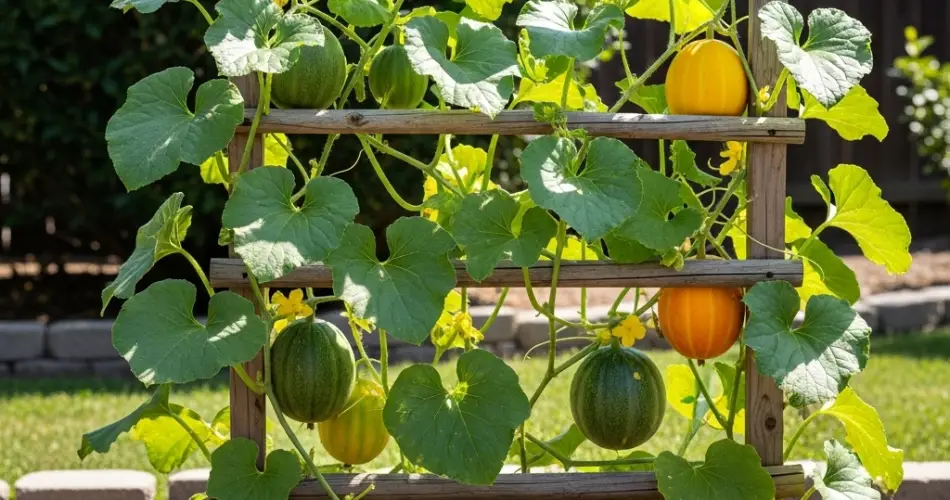Melons are one of the most rewarding fruits to grow in a home garden, offering sweet, juicy harvests that taste far better than store-bought varieties. But while delicious, melon plants can be challenging to manage. Their sprawling vines spread across the ground, consuming valuable space and exposing fruits to pests, rot, and uneven ripening. For gardeners with limited room—or those who prefer tidy, efficient plots—growing melons vertically is the solution.
Metal mesh trellises provide an especially strong and reliable support system for training melon vines upward. Durable, reusable, and capable of holding the weight of heavy fruits, they allow gardeners to enjoy abundant harvests while saving space and keeping plants healthier.
Why Grow Melons Vertically?
Traditionally, melons sprawl across garden beds, but vertical growing offers several important advantages:
-
Space efficiency: Training vines upward frees up soil space for other crops.
-
Healthier plants: Improved air circulation reduces the risk of fungal diseases.
-
Cleaner fruits: Melons are lifted off the soil, avoiding rot, dirt, and pest damage.
-
Uniform ripening: Hanging fruits receive even sunlight exposure.
-
Easier harvesting: Ripe melons are more visible and accessible when elevated.
Why Choose Metal Mesh Trellises?
While bamboo, wooden frames, and netting can support lighter crops, melons need something stronger. Metal mesh trellises are ideal because:
-
Strength: Galvanized or welded mesh can hold the significant weight of melon vines and fruits.
-
Durability: Weather-resistant materials withstand rain, sun, and wind for many seasons.
-
Flexibility: Available in panels, rolls, or grids, mesh can be adapted to various garden designs.
-
Reusability: Unlike string or netting, mesh trellises can be stored and reused year after year.
-
Neat appearance: They give gardens a clean, structured, and professional look.
Types of Metal Mesh Trellises for Melons
1. Vertical Mesh Panels
Sturdy panels of welded wire mesh are anchored upright with wooden or metal posts.
-
Advantages: Provide a tall, solid wall for vines to climb.
-
Best for: Compact gardens where vertical space is maximized.
2. A-Frame Mesh Trellis
Two panels of mesh are joined at the top to form a triangular “A” shape.
-
Advantages: Supports plants on both sides and allows fruits to hang down through the openings.
-
Best for: Raised beds or open plots where shade beneath the trellis can benefit lettuce or herbs.
3. Archway Trellises
Flexible metal mesh can be bent to form arches or tunnels.
-
Advantages: Creates a dramatic garden feature while holding heavy melon vines. Fruits hang overhead for easy picking.
-
Best for: Larger gardens or pathways where an edible tunnel doubles as decoration.
4. Mesh and Post Row Trellis
Horizontal rows of metal mesh are stretched between sturdy posts.
-
Advantages: Simple, effective, and inexpensive to build for long melon rows.
-
Best for: Traditional in-ground melon patches.
5. Wall-Mounted Mesh Grids
For very limited space, mesh can be attached directly to a wall or fence.
-
Advantages: Saves space, creates a living green wall of melon vines.
-
Best for: Urban patios, balconies, or small backyard gardens.
How to Grow Melons on a Metal Mesh Trellis
-
Choose the right variety: Smaller melons like cantaloupe, honeydew, and certain mini watermelons are better suited for vertical growth.
-
Prepare the soil: Amend the planting area with compost or well-rotted manure for nutrient-rich soil.
-
Install the trellis: Set up the mesh structure before planting to avoid disturbing roots later.
-
Plant seedlings at the base: Space plants 18–24 inches apart along the trellis.
-
Train the vines: As they grow, gently weave them into the mesh and secure with soft ties.
-
Support heavy fruits: Use slings made from fabric, mesh bags, or old T-shirts to cradle developing melons.
Tips for Success with Vertical Melon Growing
-
Consistent watering: Melons need regular, deep watering, especially during fruiting.
-
Mulching: Apply mulch at the base to retain moisture and suppress weeds.
-
Pollination: Encourage bees or hand-pollinate flowers to ensure good fruit set.
-
Fertilizing: Use a balanced fertilizer during early growth, then switch to potassium-rich feeding once flowering begins.
-
Harvesting: Check fruits frequently for ripeness—cantaloupes slip easily from the vine when ready, while watermelons should have a dull sound when tapped.
Design Ideas for Garden Aesthetics
Metal mesh trellises do more than just support crops; they can enhance the look of your garden:
-
Green walls: Turn a plain fence into a living wall covered in lush melon foliage.
-
Garden tunnels: Use mesh arches to create shaded walkways that double as productive spaces.
-
Mixed plantings: Train melons alongside beans or cucumbers for a layered, productive trellis.
Final Thoughts
Metal mesh trellises are one of the most effective ways to grow melons vertically. They provide the strength needed to support vigorous vines and heavy fruits, while saving space and improving overall plant health. Whether you choose a simple wall-mounted grid, an A-frame design, or an ornamental archway, mesh trellises make it possible to harvest sweet, clean, and abundant melons from even the smallest gardens.
By investing in strong trellising, gardeners not only improve yields but also create a striking vertical element that transforms their garden into a productive and beautiful space. With metal mesh trellises, your melon harvests can reach new heights—literally.



